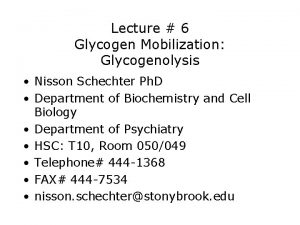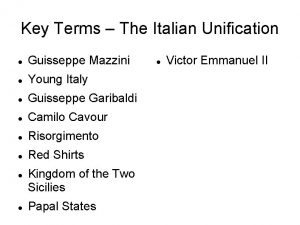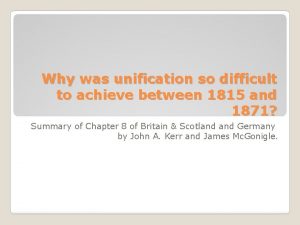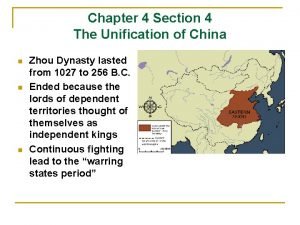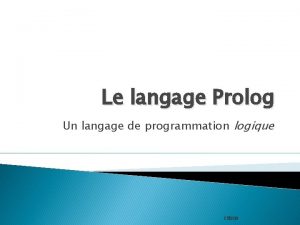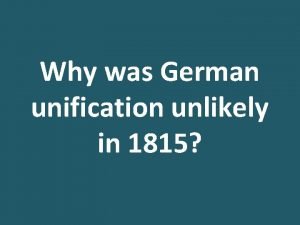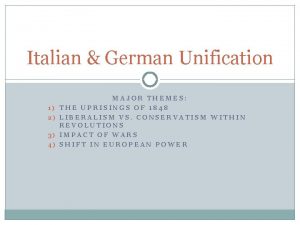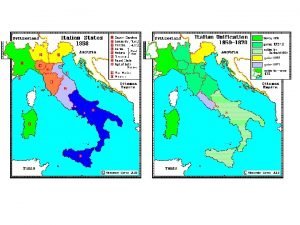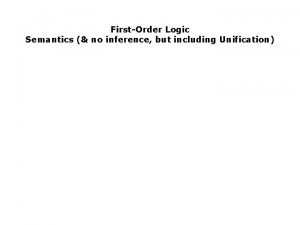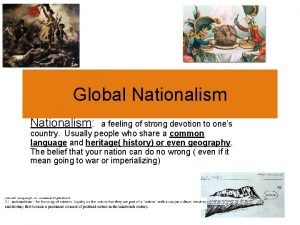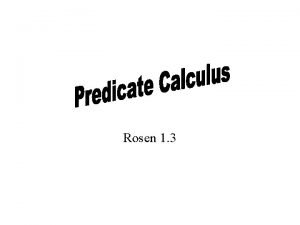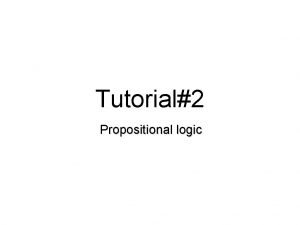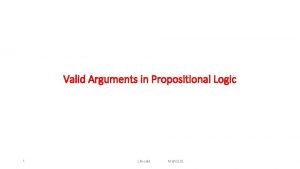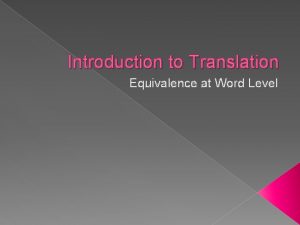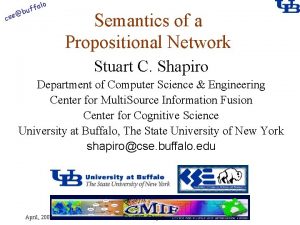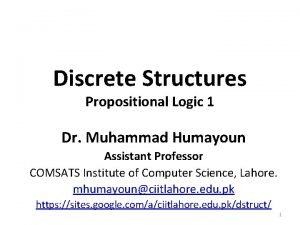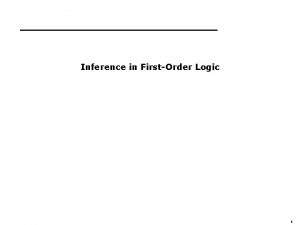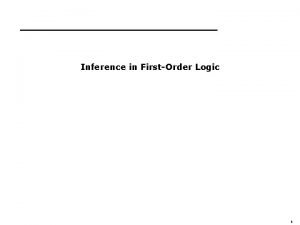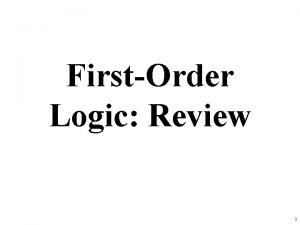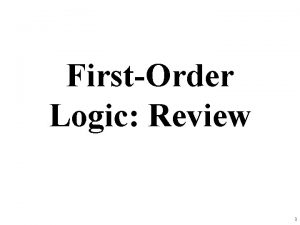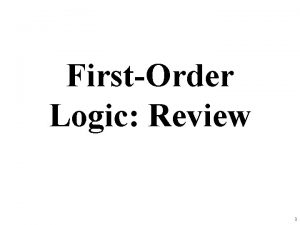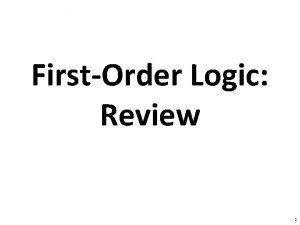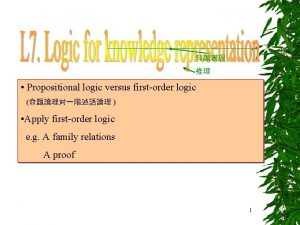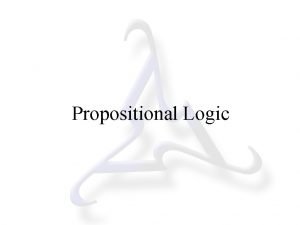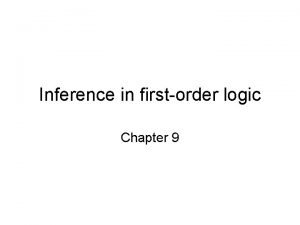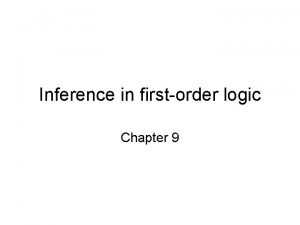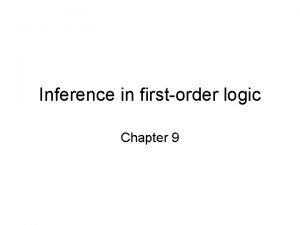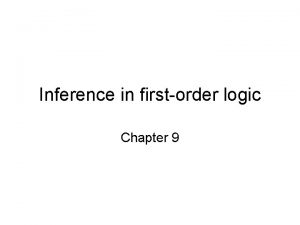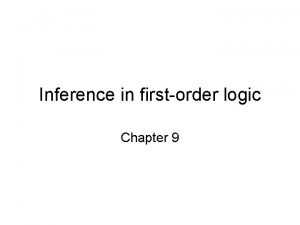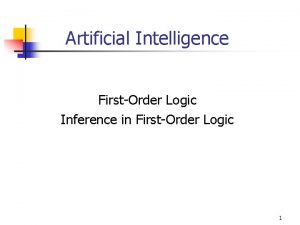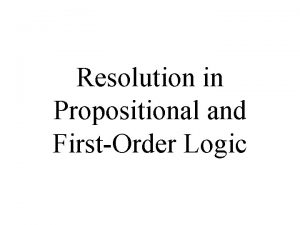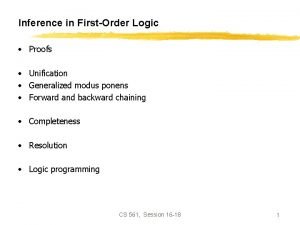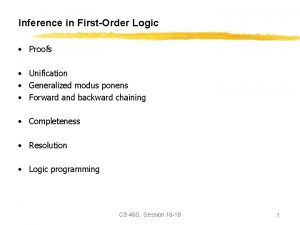Outline Reducing firstorder inference to propositional inference Unification


































- Slides: 34


Outline • • • Reducing first-order inference to propositional inference Unification Generalized Modus Ponens Forward chaining Backward chaining Resolution

Universal instantiation (UI)

Existential instantiation (EI) • For any sentence α, variable v, and constant symbol k (that does not appear elsewhere in the knowledge base): v α Subst({v/k}, α) • E. g. , x Crown(x) On. Head(x, John) yields: Crown(C 1) On. Head(C 1, John) where C 1 is a new constant symbol, called a Skolem constant • Existential and universal instantiation allows to “propositionalize” any FOL sentence or KB – EI produces one instantiation per EQ sentence – UI produces a whole set of instantiated sentences per UQ sentence

Reduction to propositional form Suppose the KB contains the following: x King(x) Greedy(x) Evil(x) King(John) Greedy(John) Brother(Richard, John) • Instantiating the universal sentence in all possible ways, we have: • The new KB is propositionalized: propositional symbols are King(John) Greedy(John) Evil(John) King(Richard) Greedy(Richard) Evil(Richard) King(John) Greedy(John) Brother(Richard, John) King(John), Greedy(John), Evil(John), King(Richard), etc.

Reduction continued • Every FOL KB can be propositionalized so as to preserve entailment – A ground sentence is entailed by new KB iff entailed by original KB • Idea for doing inference in FOL: – propositionalize KB and query – apply resolution-based inference – return result • Problem: with function symbols, there are infinitely many ground terms, – e. g. , Father(Father(John))), etc

Reduction continued Theorem: Herbrand (1930). If a sentence α is entailed by a FOL KB, it is entailed by a finite subset of the propositionalized KB Idea: For n = 0 to ∞ do create a propositional KB by instantiating with depth-$n$ terms see if α is entailed by this KB Problem: works if α is entailed, loops if α is not entailed

Other Problems with Propositionalization

Unification • Recall: Subst(θ, p) = result of substituting θ into sentence p • Unify algorithm: takes 2 sentences p and q and returns a unifier if one exists Unify(p, q) = θ where Subst(θ, p) = Subst(θ, q) • Example: p = Knows(John, x) q = Knows(John, Jane) Unify(p, q) = {x/Jane}

Unification examples • simple example: query = Knows(John, x), i. e. , who does John know? p Knows(John, x) • q Knows(John, Jane) Knows(y, OJ) Knows(y, Mother(y)) Knows(x, OJ) θ {x/Jane} {x/OJ, y/John} {y/John, x/Mother(John)} {fail} Last unification fails: only because x can’t take values John and OJ at the same time – But we know that if John knows x, and everyone (x) knows OJ, we should be able to infer that John knows OJ • Problem is due to use of same variable x in both sentences • Simple solution: Standardizing apart eliminates overlap of variables, e. g. , Knows(z, OJ)

Unification • To unify Knows(John, x) and Knows(y, z), θ = {y/John, x/z } or θ = {y/John, x/John, z/John} • The first unifier is more general than the second. • There is a single most general unifier (MGU) that is unique up to renaming of variables. MGU = { y/John, x/z } • General algorithm in Figure 9. 1 in the text

Recall our example… x King(x) Greedy(x) Evil(x) King(John) y Greedy(y) Brother(Richard, John) And we would like to infer Evil(John) without propositionalization

Generalized Modus Ponens (GMP) p 1', p 2', … , pn', ( p 1 p 2 … pn q) Subst(θ, q) where we can unify pi‘ and pi for all i Example: p 1' is King(John) p 1 is King(x) p 2' is Greedy(y) p 2 is Greedy(x) θ is {x/John, y/John} q is Evil(x) Subst(θ, q) is Evil(John) • Implicit assumption that all variables universally quantified

Completeness and Soundness of GMP • GMP is sound – Only derives sentences that are logically entailed – See proof on p 276 in text • GMP is complete for a KB consisting of definite clauses – Complete: derives all sentences that entailed – OR…answers every query whose answers are entailed by such a KB – Definite clause: disjunction of literals of which exactly 1 is positive, e. g. , King(x) AND Greedy(x) -> Evil(x) NOT(King(x)) OR NOT(Greedy(x)) OR Evil(x)

Inference appoaches in FOL • Forward-chaining – Uses GMP to add new atomic sentences – Useful for systems that make inferences as information streams in – Requires KB to be in form of first-order definite clauses • Backward-chaining – Works backwards from a query to try to construct a proof – Can suffer from repeated states and incompleteness – Useful for query-driven inference • Resolution-based inference (FOL) – Refutation-complete for general KB • Can be used to confirm or refute a sentence p (but not to generate all entailed sentences) – Requires FOL KB to be reduced to CNF – Uses generalized version of propositional inference rule • Note that all of these methods are generalizations of their propositional equivalents

Knowledge Base in FOL • The law says that it is a crime for an American to sell weapons to hostile nations. The country Nono, an enemy of America, has some missiles, and all of its missiles were sold to it by Colonel West, who is American.

Knowledge Base in FOL • . . . The law says that it is a crime for an American to sell weapons to hostile nations. The country Nono, an enemy of America, has some missiles, and all of its missiles were sold to it by Colonel West, who is American. it is a crime for an American to sell weapons to hostile nations: American(x) Weapon(y) Sells(x, y, z) Hostile(z) Criminal(x) Nono … has some missiles, i. e. , x Owns(Nono, x) Missile(x): Owns(Nono, M 1) and Missile(M 1) … all of its missiles were sold to it by Colonel West Missile(x) Owns(Nono, x) Sells(West, x, Nono) Missiles are weapons: Missile(x) Weapon(x) An enemy of America counts as "hostile“: Enemy(x, America) Hostile(x) West, who is American … American(West) The country Nono, an enemy of America … Enemy(Nono, America)

Forward chaining proof

Forward chaining proof

Forward chaining proof

Properties of forward chaining • Sound and complete for first-order definite clauses • Datalog = first-order definite clauses + no functions • FC terminates for Datalog in finite number of iterations • May not terminate in general if α is not entailed

Recall: Propositional Resolution-based Inference We want to prove: We first rewrite into conjunctive normal form (CNF). A “conjunction of disjunctions” literals (A B) (B C D) Clause • Any KB can be converted into CNF • k-CNF: exactly k literals per clause CS 271, Fall 2007: Professor Padhraic Smyth Topic 9: First-Order Inference 38

Resolution Examples (Propositional)

Resolution Algorithm • The resolution algorithm tries to prove: • • Generate all new sentences from KB and the query. One of two things can happen: 1. We find which is unsatisfiable, i. e. we can entail the query. 2. We find no contradiction: there is a model that satisfies the Sentence (non-trivial) and hence we cannot entail the query. CS 271, Fall 2007: Professor Padhraic Smyth Topic 9: First-Order Inference 40

Resolution example • KB = (B 1, 1 (P 1, 2 P 2, 1)) B 1, 1 • α = P 1, 2 True False in all worlds

Resolution in FOL • Full first-order version: l 1 ··· lk, m 1 ··· mn Subst(θ , l 1 ··· li-1 li+1 ··· lk m 1 ··· mj-1 mj+1 ··· mn) where Unify(li, mj) = θ. • The two clauses are assumed to be standardized apart so that they share no variables. • For example, Rich(x) Unhappy(x) Rich(Ken) Unhappy(Ken) with θ = {x/Ken} • Apply resolution steps to CNF(KB α); complete for FOL

Converting FOL sentences to CNF Original sentence: Everyone who loves all animals is loved by someone: x [ y Animal(y) Loves(x, y)] [ y Loves(y, x)] 1. Eliminate biconditionals and implications x [ y Animal(y) Loves(x, y)] [ y Loves(y, x)] 2. Move inwards: Recall: x p ≡ x p, x p ≡ x p x [ y ( Animal(y) Loves(x, y))] [ y Loves(y, x)] x [ y Animal(y) Loves(x, y)] [ y Loves(y, x)] x [ y Animal(y) Loves(x, y)] [ y Loves(y, x)]

Conversion to CNF contd. 3. Standardize variables: each quantifier should use a different one x [ y Animal(y) Loves(x, y)] [ z Loves(z, x)] 3. Skolemize: a more general form of existential instantiation. Each existential variable is replaced by a Skolem function of the enclosing universally quantified variables: x [Animal(F(x)) Loves(x, F(x))] Loves(G(x), x)

Conversion to CNF contd.

Recall: Example Knowledge Base in FOL . . . it is a crime for an American to sell weapons to hostile nations: American(x) Weapon(y) Sells(x, y, z) Hostile(z) Criminal(x) Nono … has some missiles, i. e. , x Owns(Nono, x) Missile(x): Owns(Nono, M 1) and Missile(M 1) … all of its missiles were sold to it by Colonel West Missile(x) Owns(Nono, x) Sells(West, x, Nono) Missiles are weapons: Missile(x) Weapon(x) An enemy of America counts as "hostile“: Enemy(x, America) Hostile(x) West, who is American … American(West) The country Nono, an enemy of America … Enemy(Nono, America) Can be converted to CNF

Resolution proof

Second Example KB: Everyone who loves all animals is loved by someone Anyone who kills animals is loved by no-one Jack loves all animals Either Curiosity or Jack killed the cat, who is named Tuna Query: Did Curiousity kill the cat? Inference Procedure: Express sentences in FOL Convert to CNF form and negated query See page 299 in text for details (more complex inference than last example) (answer to query: yes)

Resolution-based Inference

Summary • Inference in FOL – Simple approach: reduce all sentences to PL and apply propositional inference techniques – Generally inefficient • FOL inference techniques – Unification – Generalized Modus Ponens • Forward-chaining: complete with definite clauses – Resolution-based inference • Refutation-complete • Read Chapter 9 – Many other aspects of FOL inference we did not discuss in class
 Reducing vs non reducing sugar
Reducing vs non reducing sugar What is reducing sugar
What is reducing sugar Fates of glucose 6 phosphate
Fates of glucose 6 phosphate Fehling's test for sucrose
Fehling's test for sucrose Chapter 23 lesson 3 nationalism unification and reform
Chapter 23 lesson 3 nationalism unification and reform Obstacles to italian unification
Obstacles to italian unification German and italian unification compare and contrast
German and italian unification compare and contrast Germany before unification
Germany before unification Stages of german unification
Stages of german unification Unification algorithm example
Unification algorithm example Why was italian unification difficult to achieve
Why was italian unification difficult to achieve Sardina
Sardina Unification of italy class 10
Unification of italy class 10 Unification of china
Unification of china Unification operating model
Unification operating model C section
C section Prolog langage
Prolog langage Germany before 1871
Germany before 1871 Love my country
Love my country Italian risorgimento timeline
Italian risorgimento timeline Prolog unification
Prolog unification Unification in first order logic
Unification in first order logic Italian unification summary
Italian unification summary Gauge coupling unification
Gauge coupling unification Strong devotion
Strong devotion National unification and the national state
National unification and the national state Obstacles to german unification
Obstacles to german unification Germany before unification
Germany before unification Quotation sandwich example
Quotation sandwich example Propositional functions examples
Propositional functions examples Propositional logic examples and solutions
Propositional logic examples and solutions Valid arguments in propositional logic
Valid arguments in propositional logic Translation by more neutral/less expressive word
Translation by more neutral/less expressive word Propositional network
Propositional network Discrete math propositional logic
Discrete math propositional logic


